Alexandros-Apostolos A. Boulogeorgos
Simultaneous Information and Control Signalling Protocol for RIS-Empowered Wireless Systems
Aug 06, 2025Abstract:Integration of RIS in radio access networks requires signaling between edge units and the RIS microcontroller (MC). Unfortunately, in several practical scenarios, the signaling latency is higher than the communication channel coherence time, which causes outdated signaling at the RIS. To counterbalance this, we introduce a simultaneous information and control signaling (SICS) protocol that enables operation adaptation through wireless control signal transmission. SICS assumes that the MC is equipped with a single antenna that operates at the same frequency as the RIS. RIS operates in simultaneous transmission and reflection (STAR) mode, and the source employs non-orthogonal multiple access (NOMA) to superposition the information signal to the control signal. To maximize the achievable user data rate while ensuring the MC's ability to decode the control signal, we formulate and solve the corresponding optimization problem that returns RIS's reflection and transmission coefficients as well as the superposition coefficients of the NOMA scheme. Our results reveal the robustness of the SICS approach.
Optical RIS-enabled Multiple Access Communications
Feb 10, 2025



Abstract:In this paper, we identify optical reconfigurable intelligent surfaces (ORISs) as key enablers of next-generation free-space optical (FSO) multiple access systems. By leveraging their beam steering and beam splitting capabilities, ORISs are able to effectively address line-of-sight (LoS) constraints, while enabling multi-user connectivity. We consider an ORIS-assisted non-orthogonal multiple access (NOMA) system model consisting of a single transmitter (Tx) and two receivers (Rxs). We derive novel analytical expressions to characterize the statistical particularities of the Tx-ORIS-Rx communication channel. Building upon the aforementioned expressions, we investigate the outage performance of the Rxs by deriving exact analytical expressions for the outage probability (OP) of each Rx. To provide deeper insights into the impact of various system parameters and physical conditions on the outage performance of each Rx, we conduct a high signal-to-noise ratio (SNR) analysis, that returns asymptotic expressions for the Rxs OPs at the high-SNR regime. Monte Carlo simulations validate the analysis, demonstrate the effectiveness of ORIS-enabled NOMA under a variety of configurations and physical scenarios, and showcase its superiority over its orthogonal-based counterpart.
Covert Communications in Active-IOS Aided Uplink NOMA Systems With Full-Duplex Receiver
Feb 05, 2025Abstract:In this paper, an active intelligent omni-surface (A-IOS) is deployed to aid uplink transmissions in a non-orthogonal multiple access (NOMA) system. In order to shelter the covert signal embedded in the superposition transmissions, a multi-antenna full-duplex (FD) receiver is utilized at the base-station to recover signal in addition to jamming the warden. With the aim of maximizing the covert rate, the FD transmit and receive beamforming, A-IOS refraction and reflection beamforming, NOMA transmit power, and FD jamming power are jointly optimized. To tackle the non-convex covert rate maximization problem subject to the highly coupled system parameters, an alternating optimization algorithm is designed to iteratively solve the decoupled sub-problems of optimizing the system parameters. The optimal solutions for the sub-problems of the NOMA transmit power and FD jamming power optimizations are derived in closed-form. To tackle the rank-one constrained non-convex fractional programming of the A-IOS beamforming and FD beamforming, a penalized Dinkelbach transformation approach is proposed to resort to the optimal solutions via semidefinite programming. Numerical results clarify that the deployment of the A-IOS significantly improves the covert rate compared with the passive-IOS aided uplink NOMA system. It is also found that the proposed scheme provides better covert communication performance with the optimized NOMA transmit power and FD jamming power compared with the benchmark schemes.
Modeling blockage in high directional wireless. systems
Nov 17, 2024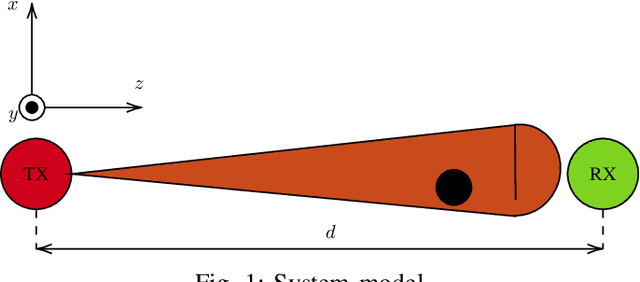
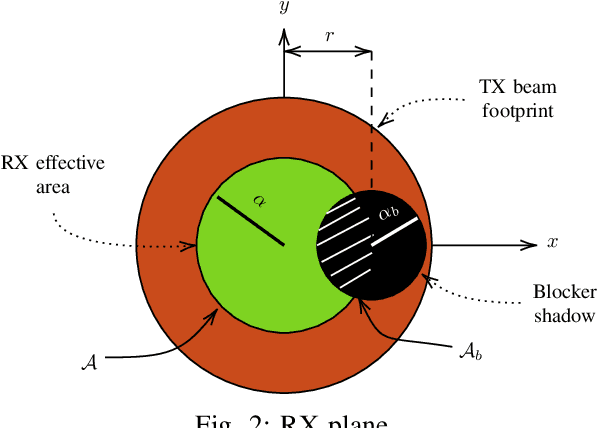
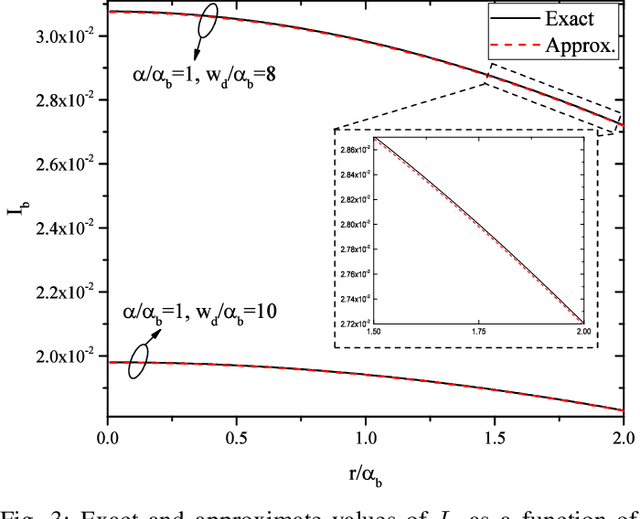
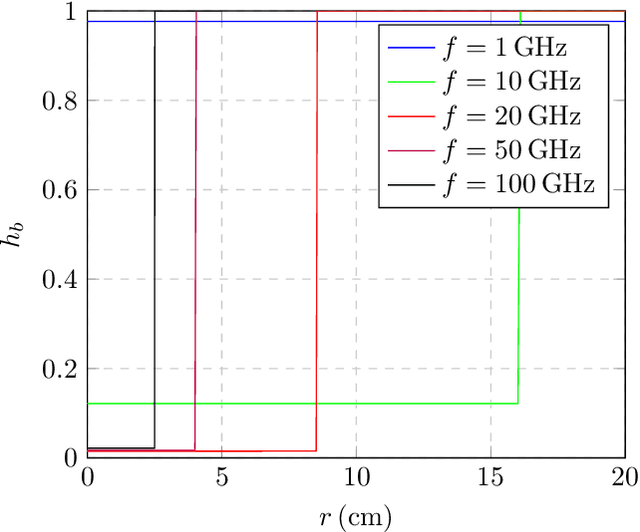
Abstract:While the wireless word moves towards higher frequency bands, new challenges arises, due to the inherent characteristics of the transmission links, such as high path and penetration losses. Penetration losses causes blockages that in turn can significantly reduce the signal strength at the receiver. Most published contributions consider a binary blockage stage, i.e. either fully blocked or blockage-free links. However, in realistic scenarios, a link can be partially blocked. Motivated by this, in this paper, we present two low-complexity models that are based on tight approximations and accommodates the impact of partial blockage in high-frequency links. To demonstrate the applicability of the derived framework, we present closed-form expressions for the outage probability for the case in which the distance between the center of the receiver plane and the blocker's shadow center follow uniform distribution. Numerical results verify the derived framework and reveal how the transmission parameters affect blockage.
Active-RIS-Aided Covert Communications in NOMA-Inspired ISAC Wireless Systems
Jun 30, 2024



Abstract:Non-orthogonal multiple access (NOMA)-inspired integrated sensing and communication (ISAC) facilitates spectrum sharing for radar sensing and NOMA communications, whereas facing privacy and security challenges due to open wireless propagation. In this paper, active reconfigurable intelligent surface (RIS) is employed to aid covert communications in NOMA-inspired ISAC wireless system with the aim of maximizing the covert rate. Specifically, a dual-function base-station (BS) transmits the superposition signal to sense multiple targets, while achieving covert and reliable communications for a pair of NOMA covert and public users, respectively, in the presence of a warden. Two superposition transmission schemes, namely, the transmissions with dedicated sensing signal (w-DSS) and without dedicated sensing signal (w/o-DSS), are respectively considered in the formulations of the joint transmission and reflection beamforming optimization problems. Numerical results demonstrate that active-RIS-aided NOMA-ISAC system outperforms the passive-RIS-aided and without-RIS counterparts in terms of covert rate and trade-off between covert communication and sensing performance metrics. Finally, the w/o-DSS scheme, which omits the dedicated sensing signal, achieves a higher covert rate than the w-DSS scheme by allocating more transmit power for the covert transmissions, while preserving a comparable multi-target sensing performance.
On the Reliability and Security of Ambient Backscatter Uplink NOMA Networks
May 11, 2024



Abstract:A fundamental objective of the forthcoming sixth-generation wireless networks is to concurrently serve a vast array of devices many of which, such as Internet-of-Things (IoT) sensors, are projected to have low power requirements or even operate in a battery-free manner. To achieve this goal, non-orthogonal multiple access (NOMA) and ambient backscatter communications (AmBC) are regarded as two pivotal and promising technologies. In this work, we present a novel analytical framework for studying the reliability and security of uplink NOMA-based AmBC systems. Specifically, closed-form analytical expressions for both NOMA-users' and IoT backscatter device's (BD's) outage probabilities (OPs) are derived for both cases of perfect and imperfect successive interference cancellation (SIC). In addition, assuming that one NOMA-user transmits an artificial noise in order to enhance system's security, the physical layer security (PLS) of the system is investigated by extracting analytical expressions for NOMA-users' and BD's intercept probabilities (IPs). To gain insightful understandings, an asymptotic analysis is carried out by focusing on the high signal-to-noise (SNR) regime, which reveals that NOMA-users and BDs face outage floors in the high SNR regime as well as that IPs reach constant values at high SNR. Additionally, practical insights regarding how different system parameters affect these OP floors and IP constant values are extracted. Numerical results verify the accuracy of othe developed theoretical framework, offer performance comparisons between the presented NOMA-based AmBC system and a conventional orthogonal multiple access-based AmBC system, and reveal the impact of different system parameters on the reliability and security of NOMA-based AmBC networks.
Training Terahertz Wireless Systems to Battle I/Q Imbalance
Jun 02, 2023



Abstract:Due to the non-ideality of analog components, transceivers experience high levels of hardware imperfections, like in-phase and quadrature imbalance (IQI), which manifests itself as the mismatches of amplitude and phase between the I and Q branches. Unless proper mitigated, IQI has an important and negative impact on the reliability and efficiency of high-frequency and high-data-rate systems, such as terahertz wireless networks. Recognizing this, the current paper presents an intelligent transmitter (TX) and an intelligent receiver (RX) architecture that by employing machine learning (ML) methodologies is capable to fully-mitigate the impact of IQI without performing IQI coefficients estimation. They key idea lies on co-training the TX mapper's and RX demapper in order to respectively design a constellation and detection scheme that takes accounts for IQI. Two training approaches are implemented, namely: i) conventional that requires a considerable amount of data for training, and ii) a reinforcement learning based one, which demands a shorter dataset in comparison to the former. The feasibility and efficiency of the proposed architecture and training approaches are validated through respective Monte Carlo simulations.
* 6 pages, 4 figures
Can graph neural network-based detection mitigate the impact of hardware imperfections?
May 08, 2023
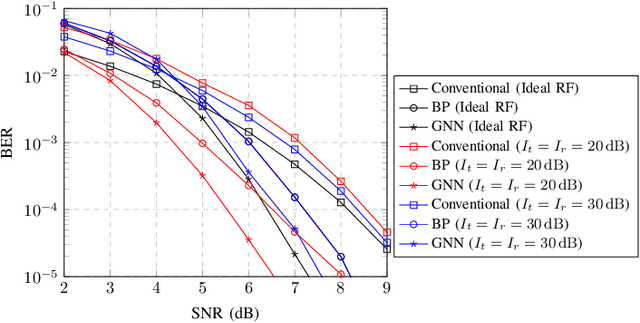
Abstract:Until recently, researchers used machine learning methods to compensate for hardware imperfections at the symbol level, indicating that optimum radio-frequency transceiver performance is possible. Nevertheless, such approaches neglect the error correcting codes used in wireless networks, which inspires machine learning (ML)-approaches that learn and minimise hardware imperfections at the bit level. In the present work, we evaluate a graph neural network (GNN)-based intelligent detector's in-phase and quadrature imbalance (IQI) mitigation capabilities. We focus on a high-frequency, high-directional wireless system where IQI affects both the transmitter (TX) and the receiver (RX). The TX uses a GNN-based decoder, whilst the RX uses a linear error correcting algorithm. The bit error rate (BER) is computed using appropriate Monte Carlo simulations to quantify performance. Finally, the outcomes are compared to both traditional systems using conventional detectors and wireless systems using belief propagation based detectors. Due to the utilization of graph neural networks, the proposed algorithm is highly scalable with few training parameters and is able to adapt to various code parameters.
Power-Optimal HARQ Protocol for Reliable Free Space Optical Communication
Mar 30, 2023Abstract:This paper investigates the usage of hybrid automatic repeat request (HARQ) protocols for power-efficient and reliable communications over free space optical (FSO) links. By exploiting the large coherence time of the FSO channel, the proposed transmission schemes combat turbulence-induced fading by retransmitting the failed packets in the same coherence interval. To assess the performance of the presented HARQ technique, we extract a theoretical framework for the outage performance. In more detail, a closed-form expression for the outage probability (OP) is reported and an approximation for the high signal-to-noise ratio (SNR) region is extracted. Building upon the theoretical framework, we formulate a transmission power allocation problem throughout the retransmission rounds. This optimization problem is solved numerically through the use of an iterative algorithm. In addition, the average throughput of the HARQ schemes under consideration is examined. Simulation results validate the theoretical analysis under different turbulence conditions and demonstrate the performance improvement, in terms of both OP and throughput, of the proposed HARQ schemes compared to fixed transmit power HARQ benchmarks.
Localization as a key enabler of 6G wireless systems: A comprehensive survey and an outlook
Feb 04, 2023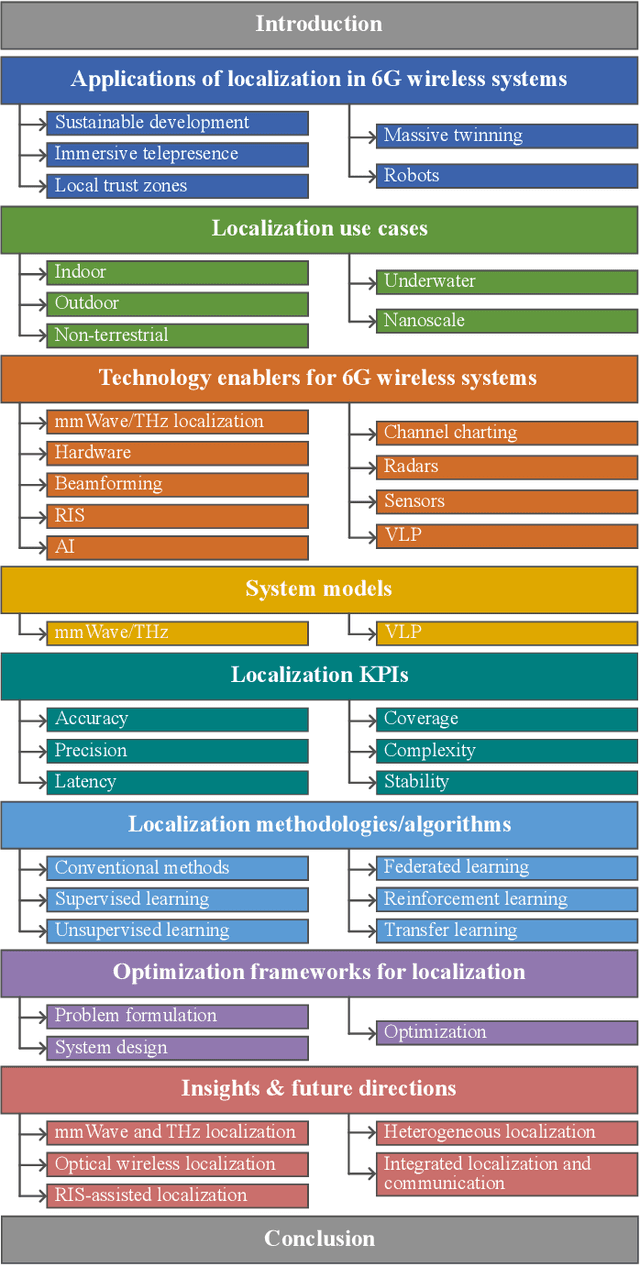
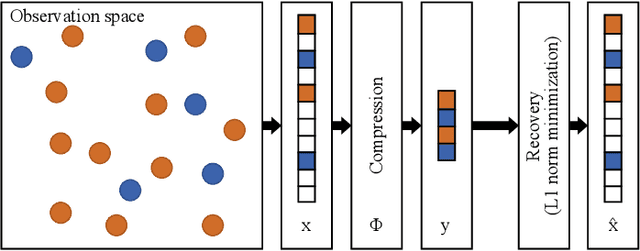


Abstract:When fully implemented, sixth generation (6G) wireless systems will constitute intelligent wireless networks that enable not only ubiquitous communication but also high-accuracy localization services. They will be the driving force behind this transformation by introducing a new set of characteristics and service capabilities in which location will coexist with communication while sharing available resources. To that purpose, this survey investigates the envisioned applications and use cases of localization in future 6G wireless systems, while analyzing the impact of the major technology enablers. Afterwards, system models for millimeter wave, terahertz and visible light positioning that take into account both line-of-sight (LOS) and non-LOS channels are presented, while localization key performance indicators are revisited alongside mathematical definitions. Moreover, a detailed review of the state of the art conventional and learning-based localization techniques is conducted. Furthermore, the localization problem is formulated, the wireless system design is considered and the optimization of both is investigated. Finally, insights that arise from the presented analysis are summarized and used to highlight the most important future directions for localization in 6G wireless systems.
 Add to Chrome
Add to Chrome Add to Firefox
Add to Firefox Add to Edge
Add to Edge